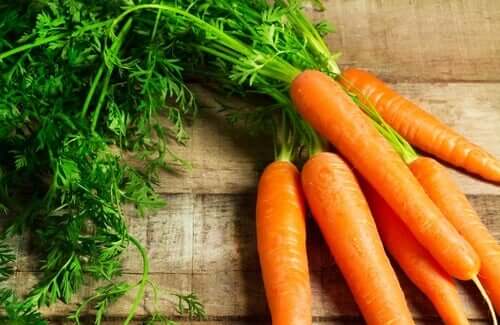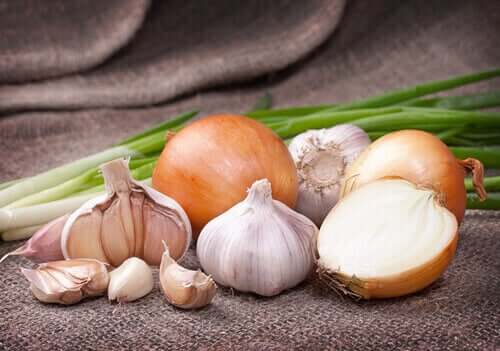The Color of Food and Its Nutritional Value


Written and verified by the nutritionist Anna Vilarrasa
“Eat at least a dark green and an orange vegetable every day.” These are the recommendations of the Ministry of Health in Canada. But why is this statement so specific? What does the color of food have to do with its quality and nutritional value?
Broadly speaking we must say that not all foods of the same color have the same properties. Nutritionally speaking, it’s difficult to equate cow’s milk with onions, tuna with tomatoes or nuts with whole wheat pasta.
However, there’s something to fruit and vegetables and their colors. Thus, their color does give us information about their properties.
Phytochemicals – vegetable pigments
All foods contain macronutrients (carbohydrates, lipids, and proteins) and micronutrients. You may know them under the names of vitamins and minerals. But in addition, plant foods also contain other non-nutritive components: phytochemicals.
Phytochemicals are present in plants for their own benefit. But as it turns out they also have a nutritional impact on our bodies. Most of them play a powerful antioxidant role and protect against diseases such as cancer, and degenerative and cardiovascular diseases.
There’s exhaustive research going on in this field that will eventually allow us to delve into what the color of food means in regards to their health benefits to us.
Find out more: Foods Rich in Vitamin A
What the color of a food tells us
In general, we can group the phytochemicals that give color to food into 3 large groups: carotenoids, chlorophyll, and anthocyanins.
Carotenes – beyond the skin

The carotenoid pigments are important for us, but we cannot synthesize them on our own. This is why we must get them from food. They’re present in orange, yellow and red fruit and vegetables.
Scientific evidence indicates that carotenoid consumption has to do with a lower risk of cardiovascular problems. They’re also powerful antioxidants, protect the skin and contribute to good eye health.
Know that the health benefits of carotenoids come only from whole foods. At the moment, researchers haven’t observed the same effect from commercial nutritional supplements.
The types of food richest in carotenoids, among others, are:
- Reds: tomatoes, cherries, raspberries, watermelon, and red peppers
- Oranges: carrots, papaya, apricots, peaches, nectarines, squash, and sweet potatoes
- Yellows: cantaloupe melon, mango, and corn
Chlorophyll
Chlorophyll-rich foods are easy to recognize because of their green color. They basically help us oxygenate our organism, promote the elimination of heavy metals, and contribute to the good state of our intestinal flora.
In addition, some studies suggest that:
“Chlorophyllin may have antioxidant properties, helping prevent cell damage caused by free radicals.”
There’s chlorophyll in many green leafy vegetables such as chard, spinach, broccoli, asparagus, cabbage, and artichokes and also in kiwi. These vegetables are usually also rich in vitamin K, folic acid and magnesium.
In addition, most of them have a hidden secret: they’re very rich in carotenes. It’s only that the yellow pigment is hidden behind the potent chlorophyll green.
Purple anthocyanins
Finally, anthocyanins can be easily recognized by the purple and blue color they give to fruits and vegetables. Thus, the best sources are blueberries, blackberries, grapes, and red cabbage. Even though some red fruits, such as strawberries, are also rich in this component.
The antioxidant effects of anthocyanins have been linked to a lower risk of myocardial infarction in young and middle-aged women. Epidemiological studies also link regular consumption of some anthocyanin source to:
- Lower risk of cardiovascular disease
- Lower incidence of type 2 diabetes
- A neuroprotective effect
- Efficient maintenance of body weight
- Lower mortality rates
Read more Your Child’s Diet: Six Foods You Should Include in It
The color of food – what about white vegetables?

We couldn’t close the color scale without knowing what the white color of a food is trying to tell us. These vegetables often go unnoticed because they’re not as colorful. However, they also provide many specific nutrients we should highlight.
Leeks, radishes, onions, and garlic are all rich in indoles. The last two are also a source of quercetin and allicin, substances that can improve cardiovascular health.
The color of food and diet
When it comes to following a proper diet, you mustn’t rely solely on the color of food but on the nutritional value of each fruit, vegetable, and cereal as this is also determined by other components. In fact, there are many more phytonutrients in vegetables that aren’t recognizable just by their color.
Also, we can’t say that orange fruits are better than purple ones. Nor that to prevent cardiovascular disease you must only eat red food.
What’s interesting, from a chromatic point of view, is that the possible food combinations we can have daily are endless. Because the more varied your diet is the less likely it’ll be to lack a specific nutrient.
Thus, we must ensure a well-balanced contribution of all phytonutrients, and we can take advantage of the health benefits in them. Of course, keep in mind there are many more than the ones we mentioned here, in this article.
All cited sources were thoroughly reviewed by our team to ensure their quality, reliability, currency, and validity. The bibliography of this article was considered reliable and of academic or scientific accuracy.
- Russo M, Spagnuolo C, Tedesco I, Russo GL. Phytochemicals in cancer prevention and therapy: truth or dare?. Toxins (Basel). 2010;2(4):517–551. doi:10.3390/toxins2040517
- Voutilainen S., Nurmi T., Mursu J., Rissanen TH., Carotenoids and cardiovascular health. Am J Clin Nutr, 2006. 83 (6): 1265-71.
- Lanfer-Marquez U, et al. Antioxidant activity of chlorophylls and their derivatives. Food Research International. Octubre 2005. 885-891.
- Cassidy A, et al. High anthocyanin intake is associated with a reduced risk of myocardial infarction in young and middle-aged women. Circulation. Enero 2013. 127:188-196.
- Barnes S, et al. In nutrition, can we “see” what is good for us? Advances in Nutrition. Mayo 2013. 4(3): 327S-334S.
- Cassidy A, et al. High anthocyanin intake is associated with a reduced risk of myocardial infarction in young and middle-aged women. Circulation. Enero 2013. 127:188-196.
- Russo M, Spagnuolo C, Tedesco I, Russo GL. Phytochemicals in cancer prevention and therapy: truth or dare?. Toxins (Basel). 2010;2(4):517–551. doi:10.3390/toxins2040517
- Jeon YJ, et al. Effects of beta-carotene supplements on cancer prevention: meta-analysis of randomized controlled trials. Nutrition and Cancer. Noviembre 2011. 63(8): 1196-207.
- Kalt W, et al. Recent Research on the health benefits of blueberries and their anthocyanins. Advances in Nutrition. Julio 2019. nmz065.
- Lanfer-Marquez U, et al. Antioxidant activity of chlorophylls and their derivatives. Food Research International. Octubre 2005. 885-891.
- Weaver C, Marr E.T. White vegetables: a forgotten source of nutrients: purdue roundtable executive summary. Advances in Nutrition. Mayo 2013. 4(3):318S-326S.
This text is provided for informational purposes only and does not replace consultation with a professional. If in doubt, consult your specialist.








